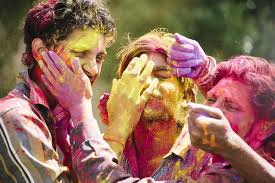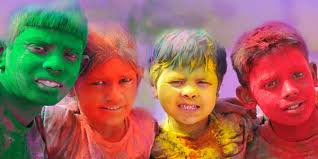Holi is one of the most vibrant and joyous festivals celebrated in India and among Hindu communities worldwide. Known as the "Festival of Colors," Holi marks the arrival of spring and the triumph of good over evil. It is observed on the full moon day of the Hindu month of Phalguna (February-March).
Legends Associated with Holi
1. The Legend of Prahlada and Holika
This is the most famous legend associated with Holi and symbolizes the victory of good over evil.
- Hiranyakashipu, a powerful demon king, wanted everyone to worship him. However, his son Prahlada was a devoted follower of Lord Vishnu.
- Angry at his son’s devotion, Hiranyakashipu tried to kill Prahlada multiple times but failed.
- Finally, he sought help from his sister Holika, who had a magical boon that made her immune to fire. She tricked Prahlada into sitting on her lap in a blazing fire.
- However, due to divine protection, Prahlada was unharmed, and Holika was burned to ashes.
- This event is celebrated with Holika Dahan, a bonfire ritual held on the night before Holi.
2. The Legend of Radha and Krishna
Holi is also associated with the playful love between Lord Krishna and Radha.
- According to legend, Krishna, who had a dark complexion, was worried that fair-skinned Radha would not love him.
- His mother, Yashoda, playfully suggested that he color Radha’s face with gulal (colored powder) to make them equal.
- Krishna and his friends playfully smeared colors on Radha and other gopis (cowherd girls), starting the tradition of playing with colors.
- This tradition is especially prominent in Barsana and Vrindavan, where Holi celebrations are grand and unique.
3. The Legend of Kamadeva
In South India, Holi is also linked to the story of Kamadeva, the god of love.
- After Lord Shiva’s wife, Sati, immolated herself, Shiva went into deep meditation.
- To bring him back to the world, the gods sent Kamadeva to awaken him.
- Kamadeva shot his flower arrows at Shiva, but Shiva, angered by the disturbance, opened his third eye and burned Kamadeva to ashes.
- Later, Rati, Kamadeva’s wife, pleaded with Shiva, who agreed to restore Kamadeva in an invisible form, representing emotions and love.
- This legend is remembered in South India, where Holi is called Kama Dahanam.
4. The Legend of Dhundhi
This legend is lesser known but is linked to children playing mischief during Holi.
- Dhundhi was a demoness who troubled children in the kingdom of Prithu.
- Due to a curse, she was vulnerable to the noise and pranks of children.
- The village boys chased her away with loud shouts and tricks, symbolizing the victory of happiness and mischief over evil.
- This is why children often engage in playful pranks during Holi.
Conclusion
Holi is not just about colors; it has deep-rooted mythological significance. It celebrates love, devotion, joy, and the triumph of good over evil. These legends make Holi one of the most meaningful and cherished festivals in Hindu culture.






0 Response to "Holi and Legends Associated with Holi Festival"
Post a Comment